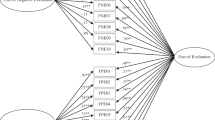Abstract
Socially anxious (SA) individuals interpret ambiguous social events negatively. It is not clear, however, whether this bias is due to general distress (e.g., depression and general anxiety) or level of social anxiety. In the current study we conducted two experiments examining interpretation bias in SA individuals using videos. Each video involved an actor or actress who approached the camera and commented on some aspect of the individual’s belongings or actions. Twenty-four (24) videos were ambiguous (e.g., “That is an interesting shirt you have on”), 24 were positive (e.g., “I really like your shoes”), and 24 were negative (e.g., “That is a horrible hair cut”). Participants were instructed to rate the emotional valance of each video as to how they would feel in that situation. SA individuals rated the valance of ambiguous social interactions as more negative than did nonanxious individuals. Moreover, SA individuals maintained this bias when compared to a high trait anxious and dysphoric control group. These findings demonstrate the unique role of social anxiety in the biased interpretation of ambiguous social interactions.
Similar content being viewed by others
References
Alloy, L. B., & Abramson, L. Y. (1988). Depressive realism: Four theoretical perspectives. In L. B. Alloy (Eds). Cognitive processes in depression (pp. 223–265) New York: Guilford.
American Psychiatric Association. (1994). Diagnostic and statistical manual of mental disorders (4th ed., rev.). Washington, DC: Author.
Amir, N., Bower, E., Briks, J., & Freshman, M. (2003). Implicit memory for positive and negative social information in individuals with and without social anxiety. Cognition and Emotion, 17, 567–583.
Amir, N., Foa, E. B., & Coles, M. (1998). Social phobics’ evaluation of ambiguous situations. Behaviour Research and Therapy, 36, 945–957.
Beck, A. T., & Steer, R. A. (1987). Beck depression inventory manual. San Antonio, TX: The Psychological Corporation.
Butler, G., & Mathews, A. (1983). Cognitive processes in anxiety. Advances in Behaviour Research and Therapy, 5, 51–62.
Constans, J. I., Penn, D. L., Ihen, G. H., & Hope, D. A. (1999). Interpretive biases for ambiguous stimuli in social anxiety. Behaviour Research and Therapy, 37, 643–651.
Foa, E. B., Franklin, M. E., Perry, K. J., & Herbert, J. D. (1996). Cognitive biases in generalized social phobia. Journal of Abnormal Psychology, 105(3), 433–439.
Garber, J., & Hollon, S. (1991). What can specificity designs say about causality in psychopathology research? Psychological Bulletin, 110, 129–136.
McNally, R. J. (2001). On the scientific status of cognitive appraisal models of anxiety disorders. Behaviour Research and Therapy, 39, 513–521.
Miller, G., & Chapman, J. (2001). Misunderstanding analysis of covariance. Journal of Abnormal Psychology, 110, 40–48.
Pozo, C., Carver, C. S., Wellens, A. R., & Scheier, M. F. (1991). Social anxiety and social perception: Construing others’ reaction to the self. Personality and Social Psychology Bulletin, 17, 355–362.
Reiss, S., Peterson, R. A., Gursky, D. M., & McNally, R. J. (1986). Anxiety sensitivity, anxiety frequency and the predictions of fearfulness. Behaviour Research and Therapy, 24, 1–8.
Roth, D., Antory, M., & Swinson, R. (2001). Interpretations for anxiety symptoms in social phobia. Behaviour Research and Therapy, 39, 129–138.
Spielberger, C. D., Gorsuch, R. L., Lushene, R., Vagg, P. R., & Jacobs, G. A. (1983). Manual for the State-Trait Anxiety Inventory. Palo Alto, CA: Consulting Psychologist Press.
Stopa, L., & Clark, D. (2000). Social phobia and the interpretation of social events. Behaviour Research and Therapy, 38, 273–283.
Veljaca, K., & Rapee, R. M. (1998). Detection of negative and positive audience behaviours by socially anxious subjects. Behaviour Research and Therapy, 36, 311–321.
Taylor, S. E., & Brown, J. D. (1988). Illusion and well being: A social psychological perspective on mental health. Psychological Bulletin, 103, 193–210.
Thorpe, & Salkovskis. (1997). Information processing in spider phobics: The stroop colour naming task may indicate strategic but not automatic attentional bias. Behaviour Research and Therapy, 35, 131–144.
Turner, S. M., & Beidel, D. C. (1988). Some further comments on the measurement of social phobia. Behaviour Research and Therapy, 26, 411–413.
Watson, D., & Friend, R. (1969). Measurement of social-evaluative anxiety. Journal of Consulting and Clinical Psychology, 33, 448–457.
Author information
Authors and Affiliations
Corresponding author
Rights and permissions
About this article
Cite this article
Amir, N., Beard, C. & Bower, E. Interpretation Bias and Social Anxiety. Cogn Ther Res 29, 433–443 (2005). https://doi.org/10.1007/s10608-005-2834-5
Issue Date:
DOI: https://doi.org/10.1007/s10608-005-2834-5



